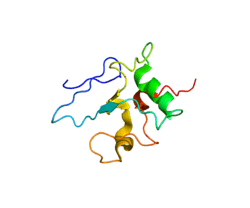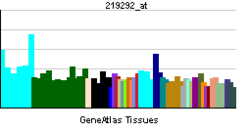THAP1
| THAP domain containing, apoptosis associated protein 1 | |||||||||||||
|---|---|---|---|---|---|---|---|---|---|---|---|---|---|
 Rendering based on PDB 2JTG. | |||||||||||||
| |||||||||||||
| Identifiers | |||||||||||||
| Symbols | THAP1 ; DYT6 | ||||||||||||
| External IDs | OMIM: 609520 MGI: 1921004 HomoloGene: 10005 GeneCards: THAP1 Gene | ||||||||||||
| |||||||||||||
| RNA expression pattern | |||||||||||||
 | |||||||||||||
| More reference expression data | |||||||||||||
| Orthologs | |||||||||||||
| Species | Human | Mouse | |||||||||||
| Entrez | 55145 | 73754 | |||||||||||
| Ensembl | ENSG00000131931 | ENSMUSG00000037214 | |||||||||||
| UniProt | Q9NVV9 | Q8CHW1 | |||||||||||
| RefSeq (mRNA) | NM_018105 | NM_199042 | |||||||||||
| RefSeq (protein) | NP_060575 | NP_950243 | |||||||||||
| Location (UCSC) | Chr 8: 42.69 – 42.7 Mb | Chr 8: 26.16 – 26.16 Mb | |||||||||||
| PubMed search | |||||||||||||
THAP domain-containing protein 1 is a protein that in humans is encoded by the THAP1 gene. The synonyme is DYT6 (Dystonia 6).[1][2][3]
Function
The protein encoded by this gene contains a THAP domain, a conserved DNA-binding domain. This protein colocalizes with the apoptosis response protein PAWR/PAR-4 in promyelocytic leukemia (PML) nuclear bodies, and functions as a proapoptotic factor that links PAWR to PML nuclear bodies. Alternatively spliced transcript variants encoding distinct isoforms have been observed.[3]
Interactions
THAP1 has been shown to interact with PAWR.[2]
Clinical significance
Thanatos-associated [THAP] domain-containing apoptosis-associated protein 1 (THAP1) is a DNA-binding protein that has been associated with DYT6 dystonia, a hereditary movement disorder involving sustained, involuntary muscle contractions.[4][5]
References
- ↑ Roussigne M, Kossida S, Lavigne AC, Clouaire T, Ecochard V, Glories A et al. (Feb 2003). "The THAP domain: a novel protein motif with similarity to the DNA-binding domain of P element transposase". Trends in Biochemical Sciences 28 (2): 66–9. doi:10.1016/S0968-0004(02)00013-0. PMID 12575992.
- ↑ 2.0 2.1 Roussigne M, Cayrol C, Clouaire T, Amalric F, Girard JP (Apr 2003). "THAP1 is a nuclear proapoptotic factor that links prostate-apoptosis-response-4 (Par-4) to PML nuclear bodies". Oncogene 22 (16): 2432–42. doi:10.1038/sj.onc.1206271. PMID 12717420.
- ↑ 3.0 3.1 "Entrez Gene: THAP1 THAP domain containing, apoptosis associated protein 1".
- ↑ Fuchs T, Gavarini S, Saunders-Pullman R, Raymond D, Ehrlich ME, Bressman SB et al. (Mar 2009). "Mutations in the THAP1 gene are responsible for DYT6 primary torsion dystonia". Nature Genetics 41 (3): 286–8. doi:10.1038/ng.304. PMID 19182804.
- ↑ Cem Sengel, Sophie Gavarini, Nutan Sharma, Laurie J Ozelius, D Cristopher Bragg (2011): Dimerization of the DYT6 dystonia protein, THAP1, requires residues within the coiled-coil domain. J Neurochem. 2011 Jul 14;: 21752024
Further reading
- Maruyama K, Sugano S (Jan 1994). "Oligo-capping: a simple method to replace the cap structure of eukaryotic mRNAs with oligoribonucleotides". Gene 138 (1-2): 171–4. doi:10.1016/0378-1119(94)90802-8. PMID 8125298.
- Suzuki Y, Yoshitomo-Nakagawa K, Maruyama K, Suyama A, Sugano S (Oct 1997). "Construction and characterization of a full length-enriched and a 5'-end-enriched cDNA library". Gene 200 (1-2): 149–56. doi:10.1016/S0378-1119(97)00411-3. PMID 9373149.
- Clouaire T, Roussigne M, Ecochard V, Mathe C, Amalric F, Girard JP (May 2005). "The THAP domain of THAP1 is a large C2CH module with zinc-dependent sequence-specific DNA-binding activity". Proceedings of the National Academy of Sciences of the United States of America 102 (19): 6907–12. doi:10.1073/pnas.0406882102. PMC 1100732. PMID 15863623.
- Rual JF, Venkatesan K, Hao T, Hirozane-Kishikawa T, Dricot A, Li N et al. (Oct 2005). "Towards a proteome-scale map of the human protein-protein interaction network". Nature 437 (7062): 1173–8. doi:10.1038/nature04209. PMID 16189514.
- Lim J, Hao T, Shaw C, Patel AJ, Szabó G, Rual JF et al. (May 2006). "A protein-protein interaction network for human inherited ataxias and disorders of Purkinje cell degeneration". Cell 125 (4): 801–14. doi:10.1016/j.cell.2006.03.032. PMID 16713569. Vancouver style error (help)
External links
- FactorBook THAP1
- Link to Wikigenes DYT6 - dystonia 6, torsion (autosomal dominant)
- Link to Wikigenes THAP1 - THAP domain containing, apoptosis